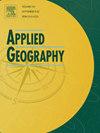Maxent modeling for predicting the potential distribution of human-elephant conflict risk in Sri Lanka
IF 4
2区 地球科学
Q1 GEOGRAPHY
引用次数: 0
Abstract
Human-elephant conflict (HEC) is a major problem that causes loss of life to both humans and elephants. While HEC risk models have been developed in past studies, there has not been any HEC risk models developed for the country with the highest annual HEC-related elephant deaths which is Sri Lanka. Thus, this study aims to develop a nationwide model to predict the risk of HEC and identify the most significant predictor variables for HEC in Sri Lanka. HEC risk variables and thirteen predictor variables were prepared using GIS tools. The MaxEnt application was used to input the risk variables (as presence points) and predictor variables (as environmental layers) and model the probability of HEC risk at 500m resolution. The modeling showed that distance to elephant distribution areas was the most important predictor variable for HEC, followed by vegetation area, elevation, rangeland area, population density, and agricultural area. The results are supported by past studies that show the preference of elephants to remain within their usual range, but venturing out for food and water when resources are lacking. This is the first study to develop a nationwide HEC risk map for Sri Lanka using machine learning.
用于预测斯里兰卡人象冲突风险潜在分布的 Maxent 模型
人象冲突(HEC)是造成人类和大象生命损失的一个主要问题。虽然在过去的研究中已经建立了人象冲突风险模型,但对于斯里兰卡这个每年因人象冲突导致大象死亡人数最多的国家来说,还没有建立任何人象冲突风险模型。因此,本研究旨在开发一个全国范围的模型,以预测斯里兰卡的大象濒危程度风险,并确定最重要的大象濒危程度预测变量。本研究使用地理信息系统(GIS)工具编制了 HEC 风险变量和 13 个预测变量。使用 MaxEnt 应用程序输入风险变量(作为存在点)和预测变量(作为环境图层),并在 500 米分辨率下建立 HEC 风险概率模型。建模结果表明,与大象分布区的距离是 HEC 最重要的预测变量,其次是植被面积、海拔高度、牧场面积、人口密度和农业面积。过去的研究结果表明,大象喜欢留在其惯常活动范围内,但在资源缺乏时会外出觅食和饮水。这是首次利用机器学习技术为斯里兰卡绘制全国范围的 HEC 风险地图。
本文章由计算机程序翻译,如有差异,请以英文原文为准。
求助全文
约1分钟内获得全文
求助全文
来源期刊

Applied Geography
GEOGRAPHY-
CiteScore
8.00
自引率
2.00%
发文量
134
期刊介绍:
Applied Geography is a journal devoted to the publication of research which utilizes geographic approaches (human, physical, nature-society and GIScience) to resolve human problems that have a spatial dimension. These problems may be related to the assessment, management and allocation of the world physical and/or human resources. The underlying rationale of the journal is that only through a clear understanding of the relevant societal, physical, and coupled natural-humans systems can we resolve such problems. Papers are invited on any theme involving the application of geographical theory and methodology in the resolution of human problems.
 求助内容:
求助内容: 应助结果提醒方式:
应助结果提醒方式:


